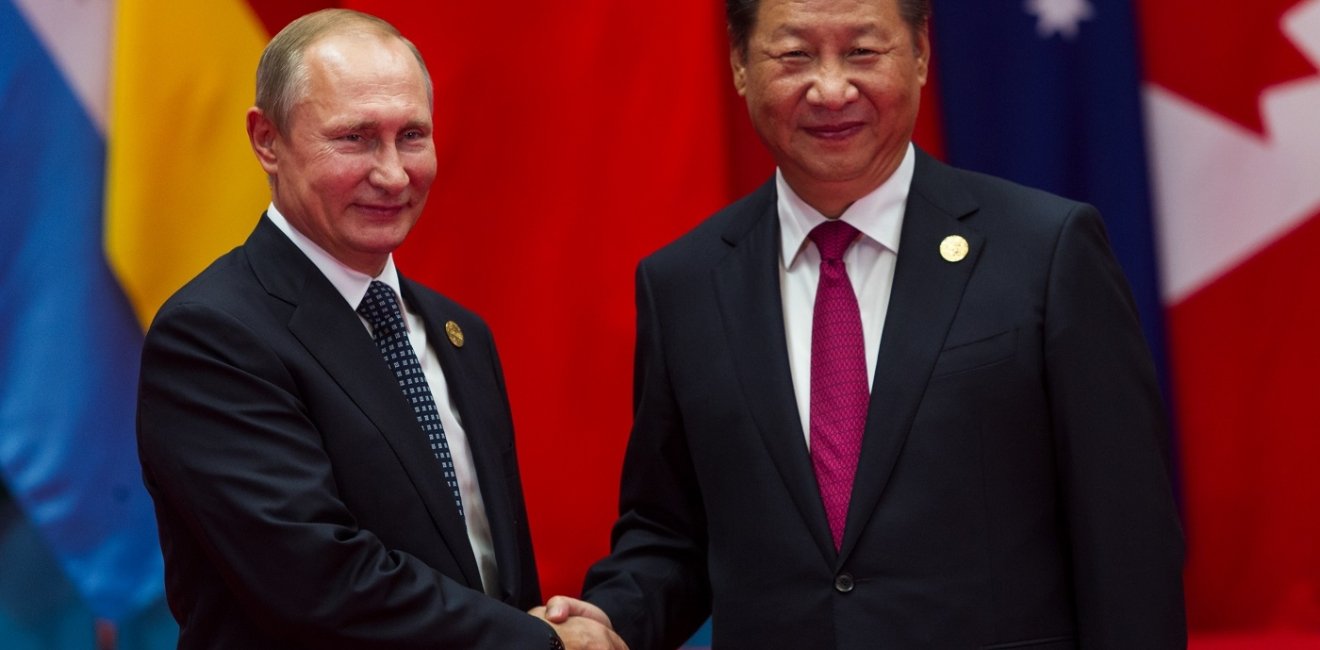
A blog of the Wilson Center
China and Russia have conducted more than 100 joint military exercises, most of them since 2017, and many of them in distant locations such as the Mediterranean, the Arctic Circle, and off the South African coast.
Sometimes there’s so much going on around us that we fail to sense the ground shifting beneath our feet.
Reports suggest that soldiers, arms, and technology are flowing between various combinations of unfriendly governments and non-state actors at an unprecedented rate. North Korea sent at least 10,000 soldiers and 1,000 containers of "equipment and munitions" to Russia. Iran is supplying weapons to Hamas in Gaza, Hezbollah in Lebanon, and the Houthis in Yemen. It has also provided Russia with at least 200 ballistic missiles and drones. While the Wagner Group itself may be no more, Russian militias and mercenaries are operating in central Africa, west Africa, and elsewhere, and Russia itself has provided targeting data to the Houthis to aid them in attacking Red Sea shipping.
But while all that is taking place, a broader, more dangerous shift may also be underway: China and Russia, with two of the world’s largest, best equipped, and best funded armed forces, are undertaking joint military projects at an unprecedented rate and in unprecedented places. It seems that what’s happening is something some analysts said couldn’t happen: the two powers are—to use a colloquialism from my high school days— “going steady.”
Once upon a time, in the 1970s and 80s, Sino-Soviet distrust meant there was relatively little military aid or weaponry sales between the two. Many analysts maintain that historical disagreements between the two are too deep-rooted for the relationship to extend beyond occasional cooperation—at least not to a level that could pose a serious threat to the West.
At a 2023 Global MIT event for foreign policy scholars, a senior lecturer in international peace and security from King’s College London’s Department of War Studies remarked, “I don’t think it’s an alliance; otherwise, China might have come to Russia’s assistance. I don’t think it will ever be an alliance. The military cooperation isn’t at a level that could truly be called an alliance relationship.” A senior researcher on China and Indo-Pacific Security at the Center for Naval Analyses described the relationship as one-sided, explaining, “For China, Russia is a consequential, though problematic, partner.” A China expert from the conservative Heritage Foundation wrote an essay in 2019 on “why the China-Russia alliance won’t last,” arguing that “the more they try to cooperate, the more their disparate interests will strain the relationship.”
Beijing and Moscow have gone to great lengths to publicly describe their relationship in glowing terms. In 2019, when Xi and Putin met in Moscow, Xi told reporters, "Russia is the country that I have visited the most times, and President Putin is my best friend and colleague.” At the time, Putin referred to Xi as “my dear friend,” and stated that “relations [between their countries] had reached an unprecedently high level.” Praise for the relationship continued even as the Kremlin was preparing for war against Ukraine. In early February of 2022, Putin and Xi jointly announced that their relationship had reached new heights where “[the] relations between Russia and China are superior to political and military alliances of the Cold War era. Friendship between the two States has no limits, [and that] there are no forbidden areas of cooperation.” The glowing descriptions seemed only to grow after Russian forces launched their brutal attacks on Ukraine. Despite entreaties from the US and Europe for China to help end the aggression—Putin publicly stated, "Relations between Russia and China are not opportunistic and not directed against anyone. Our cooperation in international matters is one of the stabilizing factors in the international arena." Xi similarly proclaimed that “China-Russia relations [are] not only in the fundamental interests of the two countries... but also conducive to peace.”
What Xi and Putin have proclaimed could be merely a feint—an effort to get us to assume there is more to the relationship than what is actually so. Xi and Putin often project propaganda or, putting it more diplomatically, “spin.” But it’s hard to see the wide-ranging military cooperation between the two countries as anything other than a gathering of authoritarian power that should concern leaders in western capitals and beyond.
After the normalization of relations at the end of the 1980s, military sales and exchanges between China and Russia rose rapidly. In 2009, for example, 68% of China’s arms imports came from Russia, and China’s arms purchases from Russia between 2000 and 2010 were 258% higher than the previous decade.
But it’s in the last decade that the growing military partnership has taken off. In September 2016, just two months after the Permanent Court of Arbitration invalidated China’s claims over the South China Sea, China and Russia launched Joint Sea 2016, where they practiced island seizure operations in the disputed waters. It’s impossible to see the subject of that exercise as anything other than an effort to intimidate countries in the region. In 2021, a joint naval exercise involving 10 warships completed a near-circle around Japan’s mainland to "ensure security in the volatile region.” And this August, Russia’s Prime Minister and China’s Premier signed a joint communique on developing joint Arctic shipping routes—as well as to increase their cooperation on “polar ship technology and icebreaker deployments,” noted by CSIS’ ChinaPower Project.
As leaders from Australia, Japan, India, and the US gathered in Tokyo for the 2022 Quad Leaders’ Summit, Russia and China conducted a joint aerial patrol over the Sea of Japan, prompting Japan's Air Self-Defense Force to scramble fighter jets—though no aircraft actually violated Japanese airspace. Around the same time, South Korea’s Joint Chiefs of Staff reported that two Chinese H-6 bombers and four Russian warplanes entered South Korea’s air defense identification zone without notice. Following Japan’s 2022 announcement to increase its defense budget in response to the growing threat from China in the region, Russia and China held a week-long joint live-fire exercise in the East China Sea. Again, it’s hard to see joint actions of China and Russia as anything less than a blunt effort to intimidate the West and its allies.
2024 has brought plenty of signs that military cooperation—military strategizing—is only growing stronger. As of July, China and Russia had participated in more than 102 joint military exercises, most occurring since 2017. A recent collaboration involved anti-submarine drills in the Pacific, which Russia says aim to improve coordination in detecting and neutralizing enemy submarines—an increasingly critical skill in modern naval warfare. In September, China played a key role in "Ocean-2024," Russia's largest naval exercise in 30 years, involving more than 400 warships, 120 aircraft, and 90,000 personnel. And Russia-China joint military drills have even entered the US air defense identification zone—coming as close as 200 miles off Alaska’s coast during their eighth aerial patrol in 2024. Weeks after China joined Russia in flying near Alaska, China’s Coast Guard announced it had entered Arctic Ocean waters for the first time in a joint patrol conducted with Russian forces.
Recently, Moscow and Beijing have broadened their cooperation to include other countries of concern to the West. For example, they have included Iran in the Middle East, and Russia has proposed greater military cooperation with North Korea.
In an era of information wars and weaponized disinformation, it’s sometimes hard to discern whether there’s truly fire behind the smoke. In a time of growing exchanges of weaponry and fighters between a number of countries around the world, it’s sometimes hard to see the transactions as being more than just that—transactions.
But when two countries involved are among the world’s most powerful, and when they act in such strong opposition to long-established priorities of the free world, and when those two leaders say their friendship will “continue for generations,” maybe, just maybe, we should sit up and take notice.
This blog was researched and drafted with assistance from Dhruvi Thakker and Chelsea Acheampong.
Author


Kissinger Institute on China and the United States
The Kissinger Institute works to ensure that China policy serves American long-term interests and is founded in understanding of historical and cultural factors in bilateral relations and in accurate assessment of the aspirations of China’s government and people. Read more


Kennan Institute
After more than 50 years as a vital part of the Wilson Center legacy, the Kennan Institute has become an independent think tank. You can find the current website for the Kennan Institute at kennaninstitute.org. Please look for future announcements about partnership activities between the Wilson Center and the Kennan Institute at Wilson Center Press Room. The Kennan Institute is the premier US center for advanced research on Eurasia and the oldest and largest regional program at the Woodrow Wilson International Center for Scholars. The Kennan Institute is committed to improving American understanding of Russia, Ukraine, Central Asia, the South Caucasus, and the surrounding region through research and exchange. Read more

Explore More in Stubborn Things
Browse Stubborn Things
Spying on Poachers

China and the Chocolate Factory

India: Economic Growth, Environmental Realities

